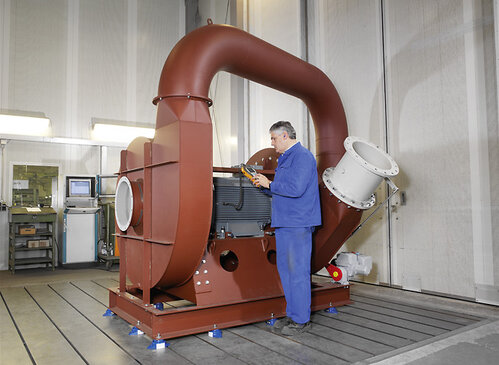Higher efficiency rates as a result of two-stage radial fans with a power output of up to 400 kW.
Flames need a controlled air flow in order to produce the best possible thermal effect, as even the smiths of classical antiquity knew. In modern cement works, however, fire and heat or thermal energy is still a functional and economic criterion for the production process. The increasing use of secondary fuels has led here to the introduction of new burner technologies. Engineers at Venti Oelde have now discovered how to increase still further the already outstanding level of efficiency and net output by means of innovative air technology. They owe their knowledge to the evaluation of specific operating data and to “finite element” analysis.
Although it does not initially look like spectacular progress, it is nevertheless a genuine innovation and the result of systematic optimisation and efficiency-increasing activities. The background is this: the intake of air or oxygen in the pressure range between 250 and 400 mbar into the modern rotary kilns in cement works cannot be achieved with “standard systems”. It was not until the arrival of two-stage centrifugal fans, using a single motor with an output of up to 400 kW, with a compact construction and a highly simplified control system, that the necessary flexibility was achieved for conforming to the technical circumstances and meeting the profitability requirements of the cement industry.
The decision in favour of this new forced-draft technology has now been taken by managers in more than 100 cement works all over the world in which modernisation and environmental protection programmes are currently being carried out. Directly after publication of the initial results from the practical tests, this technology was accepted as being “state of the art”. Innovative kiln technology to improve use of secondary fuels acted as the trigger. They provide a higher energy yield with lower energy expenditure and the highest possible level of environmental compatibility. On closer examination, however, the 400 mbar burners have proved to be highly efficient in combination with the new, two-stage, high-performance radial fans.

Economical, ecological
Alternative fuels such as used wood, tyres, plastic waste, sewage sludge, animal fat and animal meal are gaining in significance in the cement industry. Burning scrap and waste as secondary fuels not only enables use to be made of their calorific content and fossil fuels to be conserved; in addition to this, for example, the use of ash in concrete also allows savings to be made in raw materials and aggregates. The combustion process is recognised as producing low quantities of residue. Waste is recycled not only in terms of energy but also in terms of substance, and the relief this gives to landfill sites regarded as advantageous. A number of studies, some of them carried out by the Federal Environmental Office, have shown that the use of secondary fuel has to be assessed as positive even with regard to climate protection.
In Germany, for instance, it is no longer allowed to dump waste unless it has first been thermally treated (or in other words burnt). This treatment is provided by waste incineration plants and co-combustion plants such as cement works. The resultant overall effect is thus positive, and is particularly great in combination with cement works because of their thermal efficiency levels.
Technological efficiency
Primary energy conservation in the cement industry attributable to the physical recycling of secondary raw materials has risen rapidly in recent years. According to relevant investigations, were it not for the physical recycling of secondary raw materials, the consumption of primary energy in concrete and cement works would be about 17 per cent higher. This does not even take into account the energy content of the secondary fuels used annually in cement burning, i.e. the energy recycling of waste materials.
However, because of the large variety of secondary fuels that are used, the requirements imposed on the process technologies are enormous. Despite the uncertainty surrounding the question of the extent to which the trend towards secondary fuels will continue in coming years, the major kiln manufacturers have reacted to it with ground-breaking and environmentally more responsible new developments. Modern burners are similar in appearance to the spaceships in futuristic films. They have to be able to burn solid fuels, liquid fuels, dust and any combination of these three without leaving any residues. Well designed air ducts and pipework, air generally and appropriate high-performance fans, are indispensable for generating suitably tight, bundled flames while avoiding temperature peaks from particles burning outside the flame.
However, as was mentioned at the beginning of this dissertation, it is not possible to achieve the high pressure necessary for this purpose with relatively low volumes by using standard or off-the-peg systems. This is because the technology necessary for the required air streams and for pressures of up to 430 mbar has to generate or deliver the combustion air required for continuous operation of the burner as cheaply as possible. The development steps from a performance of 200 mbar first to 250, then to 300, and now to 430 mbar, proved to be very complex across the time-matrix. The costs to be borne by the producers, the diversity of variants of possible design layouts, and the testing of various materials played crucial roles in the implementation process. Finite-element analyses in combination with readings from the long-term operation of various fans ultimately delivered the basis for the development and production of the new air machines, but their real-life behaviour under extreme operating loads was purely theoretical knowledge at the time of their manufacture. It had to be confirmed and verified in practical use, but success was achieved.
Simplicity is better
Conventional approaches to a solution, using rotary piston blowers for instance, was too bulky and required too complicated a control system. Fans are simpler, more compact and can be produced technically more cheaply on modern plant; their vibration can be kept under control, they can be controlled through their speed of rotation and with dampers, and they can provide a stable curve across a broad performance range.
Venti thus replaced previous two-stage fans with double-motor systems and the conventional rotary piston blowers with new, two-stage centrifugal fans with centrally positioned drive. The main aim of the engineering design was not only to reduce operating costs and size but also to achieve the highest possible level of operating reliability, despite the enormously high forces and loads involved. Data collected from long-term readings were therefore placed in combination with and in relation to components, wall thicknesses and combinations of materials that had been optimised in design through finite-element analyses. The next step was to mark out with the appropriate field trials the limit areas between what was desirable from the commercial point of view and what was functionally necessary. The result was a central variable-speed motor with two shaft ends, two volute casings, and two impellers optimised in terms of design and of specific materials that now form the basic unit for the new fan system. The results were not only shorter ducting and a better balance of masses because of the reduction in vibration; other advantages arose from the stable performance curve, simplification of the control and regulating technology, the reduced space requirements and cost reductions of almost 30 per cent. The fans are delivered preconfigured and ready for installation, and can be fitted with the necessary sound insulation to dampen noise. The compact construction is retained.
Globally effective
The flow volumes of between 5,000 and 20,000 m³/hour are generated by variable-speed motors of up to 400 kW that have been tested over long periods of time. Other changes to meet individual customer specifications are possible with the aid of the Venti modular system. Any components from local manufacturers that are preferred in any given country or by any company, such as control and regulating systems, frequency converters or variable-speed motors, can likewise be used if they have been successfully tested and their design has been coordinated. Despite the flexibility of the overall concept, maximum efficiency levels, minimum costs, environmental protection and continuous operation over the whole year have to be guaranteed. This is because productivity and the reliability that is crucial to profits and quality (process reliability, in other words) are the most important principles in all the cement works in the world. The Venti developments adhere to this principle, and this fact seems to have been passed on by word-of-mouth propagation. More than 50 other (mainly individually modified) installations have already been ordered and work is already being done on further configurations.
Additionally, Ventilatorenfabrik Oelde GmbH, known as “Venti Oelde”, is no newcomer to cement technology. Centrifugal fans for a very wide variety of operational sections and with varying requirements for process technology are providing reliable service in handling process gases. Here again, Venti high-performance centrifugal fans have been in successful use for many years. They work as clean-air fans behind filters and as system fans in combination with entrainment-carbonisation heat-exchangers. When dust-laden gases are being transported, wear protection measures that have been matched to the application increase the service live.

关注万迪欧德公众号

万迪欧德抖音号
Copyright © 2022-2023 Venti Oelde (Jiangsu) Air Handling Equipment Co. Ltd All Right
备案号:ICP 2023002554 技术支持:镁诚科技